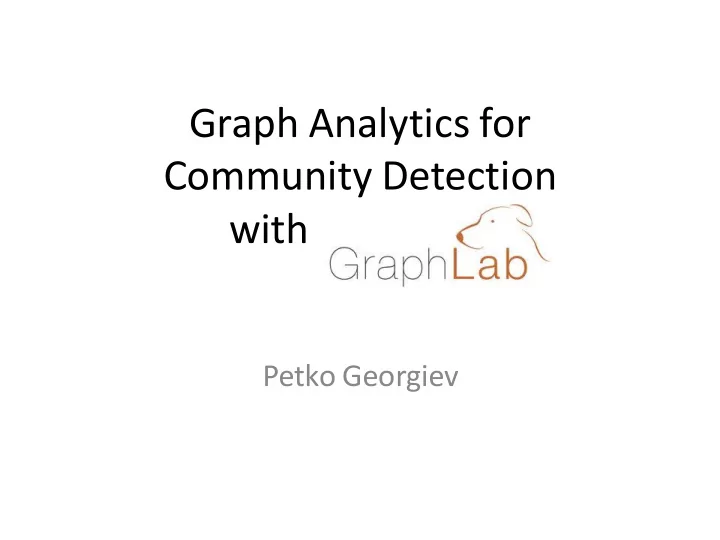

Graph Analytics for Community Detection with GraphLab Petko Georgiev
Motivation • Community detection algorithms – tools for the analysis and understanding of network data – applications in social, technological and biological networks • High-quality algorithms are slow! • Some algorithms can be run only on graphs with hundreds of vertices
GraphLab’s execution model comes to the rescue • Data graph (data/computation dependencies) • Update functions (local computation) • Sync mechanism • Consistency model (full, edge, vertex) • Scheduling primitives
Think-like-a-vertex as in Pregel • Each vertex has user defined functions: – Gather – Apply – Scatter • GraphLab also supports asynchronous convergence testing
GraphLab Toolkits Toolkit Algorithms Topic Modeling LDA Graph Analytics PageRank, K-cores Decomposition, Triangle Counting, Connected Components, Graph Colouring Clustering K-means++, Spectral Clustering Collaborative Filtering ALS, SGD, SVD++ and variants Graphical Models Structured Prediction Computer Vision Image-Stitching
GraphLab Toolkits++ Toolkit Algorithms Topic Modeling LDA Graph Analytics PageRank, K-cores Decomposition, Triangle Counting, Connected Components, Graph Colouring Clustering K-means++, Spectral Clustering Collaborative Filtering ALS, SGD, SVD++ and variants Graphical Models Structured Prediction Computer Vision Image-Stitching Community Detection TBA
Aim of study • Build a community detection toolkit • Evaluate the flexibility of GraphLab’s API • Extract commonalities in the parallel/distributed algorithm design • Measure speed-up on multicore and distributed environments • Evaluate performance benefits for large graphs
Community detection algorithms Algorithm Type Status Kernighan-Lin Modularity Divisive Implemented Maximisation Spectral Modularity Divisive In Progress Maximisation Louvain Fast Modularity Agglomerative Tentative Betweenness-based Divisive Tentative Radicchi et al. Divisive Tentative Simulated Annealing Optimisation Tentative Genetic Algorithms Optimisation Tentative Hierarchical Clustering Agglomerative Tentative
Challenges • Not all algorithms fit into the “think -like-a- vertex” model • Algorithms have several phases • Overhead of parallel implementations for small graphs • One algorithm is already quite fast (Louvain fast modularity is O(n log 2 n) for sparse graphs)
Further work • More algorithms… • Distributed deployment (EC2) • Performance analysis – Multicore environment – Distributed environment
References • Yucheng Low, Joseph Gonzalez, Aapo Kyrola, Danny Bickson, Carlos Guestrin, and Joseph M. Hellerstein (2010). " GraphLab: A New Parallel Framework for Machine Learning ." Conference on Uncertainty in Artificial Intelligence (UAI) . • Yucheng Low, Joseph Gonzalez, Aapo Kyrola, Danny Bickson, Carlos Guestrin and Joseph M. Hellerstein (2012). " Distributed GraphLab: A Framework for Machine Learning and Data Mining in the Cloud ." PVLDB . • M. E. J. Newman (2010). Networks: An Introduction . Oxford: Oxford University Press. ISBN 0-19-920665-1
Recommend
More recommend